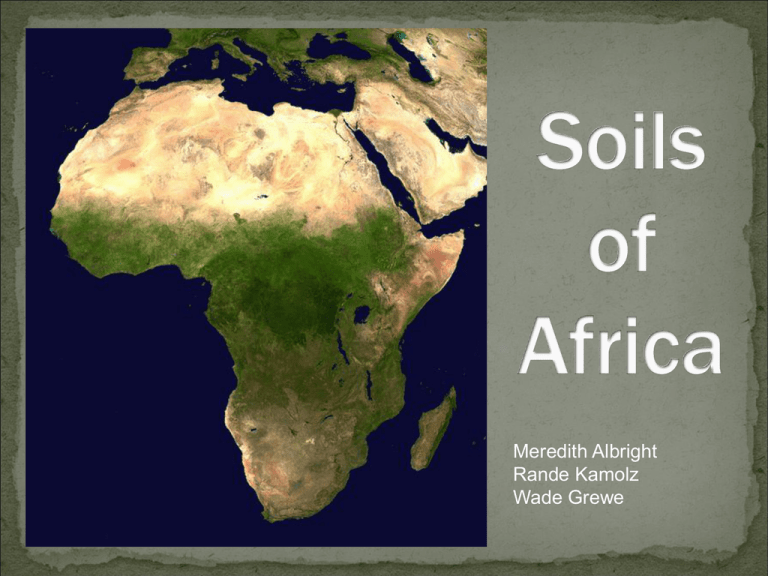
Meredith Albright
Rande Kamolz
Wade Grewe
Introduction
Climate, Biomes, and
African Soils
Great Crisis in Africa:
Desertification
Fire and soil degradation
Introduction
Soil Moisture
Characterized
by soil moisture
stress
Over 86% of
Africa is
moisture
stressed
Precipitation
Soil type
Introduction
Primary Soil Types
Aridisols - 26.4%
Sahara and Kalahari deserts
Entisols – 24.5%
Lightly weathered – dry areas
Oxisols – 14.3%
Sombic horizon (OM
accumulation) in Rwanda and
Burundi
Alfisols – 10.5%
Argillic horizon
Relatively higher fertility
Ultisols – 6.2%
Argillic horizon, deep, well-
drained soil
Low fertility
Soils
Climates
Degradation of land and soil in arid, semi-arid, and dry
sub-humid environments
Causes
Poor land management
Climatic variation
Salinization
Became mainstream during the Sahelian Drought that
began in 1968
Led to the deaths of more than 100,000 people and
millions of livestock by 1973
Human-Induced
Desertification
Areas of
Vulnerability
Natural occurrence in savanna
and grasslands
Create/maintain agricultural
areas
Dr. Michael D. King, NASA Earth observatory
Soil degradation concerns
Focus: South African soil
Fine, sandy loam
www.kirkanddonna.com/rtw/pics/0713Savannah.jpg
Compaction
1.
•
Mechanical impact of
raindrops break down
aggregates
Clay dispersion
2.
•
Fire-induced low-salt
environments
Flocculation
Clay dispersion
High salt concentration
Low salt concentration in soil solution
•Flocculation creates macro-pores
•Clay dispersion clogs pores
•High water infiltration
•Low infiltration
macro-pore
no macro-pores
_
--------++++++
_
++++++
__
----------+++++++
clay
_
+++++++
_
+
+
+
- + ++
-
- - + + +
-+
-
+ -
+
_
++
+
- + + -
_
+ +
-
Decreased water infiltration
Decreased organic matter
Decreased aggregation
Decreased water storage capacity
http://www.geography.learnontheinternet.co.uk/images/ecosystems/savanna.jpg http://www.ciat.cgiar.org/africa/images/f_afnet3.jpg http://www.nigeldennis.com/stock/images/landscapes/sa/kalahari/65000.jpg
Decrease soil quality – natural vegetation
Reduced long-term agricultural stability
Reduced food security
Solution – termites may control crust formation
www.kirkanddonna.com/rtw/pics/0713Savannah.jpg
images.jupiterimages.com/common/detail/72/51/22565172.jpg
•Where and Why
•Broad spectrum of soil types
•Biomes
•Weathering
•Desertification is a rapidly growing concern due to
intensive land use and increasing demand for crop
production.
•Unnaturally frequent fires degrade soil
•Decrease agricultural stability
•Reduce food security
Brady, N.C., R. Weil, 2008. The Nature and Properties of Soils, Fourteenth edition.
Pearson Prentice Hall, Columbus, Ohio, pp 420-423.
King, Michael, 2007. Nasa Earth Observatory - http://earthobservatory.nasa.gov/
Mando, A., L. Stroosnijder, L. Brussaard, 1996. Effects of termites on infiltration into
crusted soil. Geoderma 74: 107-113
Mills, A.J., M.V. Fey, 2004a. Frequent fires intensify soil crusting: physiochemical feedback
in the pedoderm of long-term burn experiments in South Africa. Geoderma 121: 45-64.
Mills, A., M. Fey, 2004b. Transformation of thicket to savanna reduces soil quality in the
Eastern Cape, South Africa. Plant and Soil 265: 153-163.
Snyman, H.A., 2003. Short-term response of rangeland following an unplanned fire in
terms of soil characteristics ina semi-arid climate of South Africa. Journal of Arid
Environments 55: 160-180.
Valentin, C., J.L. Rajot, D. Mitja, 2004. Responses of soil crusting, runoff and erosion to
fallowing in the sub-humid and semi-arid regions of West Africa. Agriculture, Ecosystems
and Environment 104: 287-302.
University of Minnesota, 2004. Unit 10 – Soils of Africa.
http://www.soils.umn.edu/academics/classes/soil4505/doc/unit10af.htm







